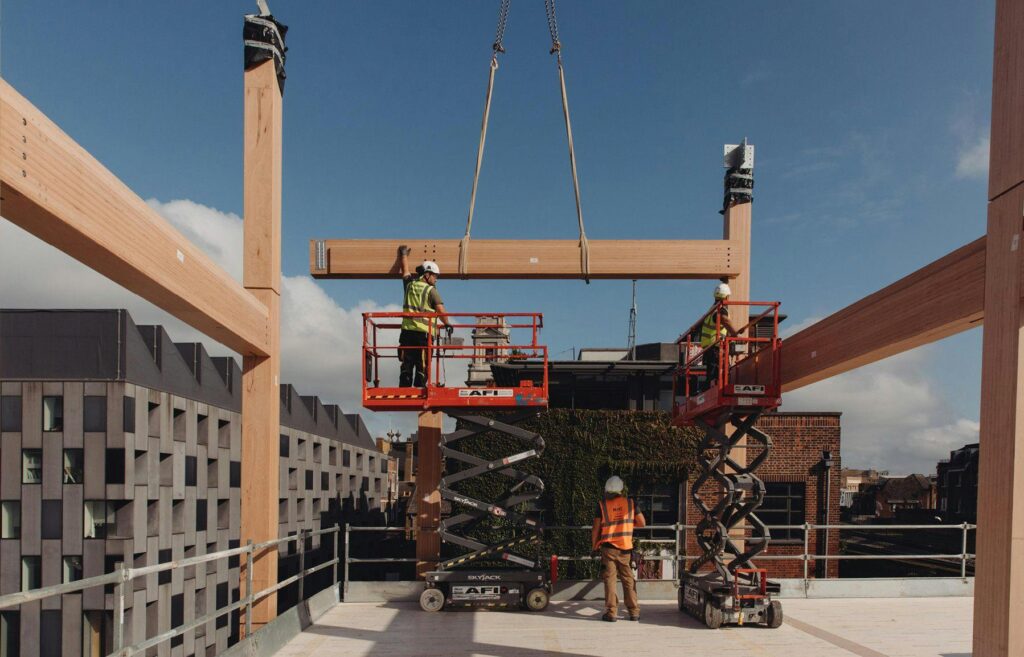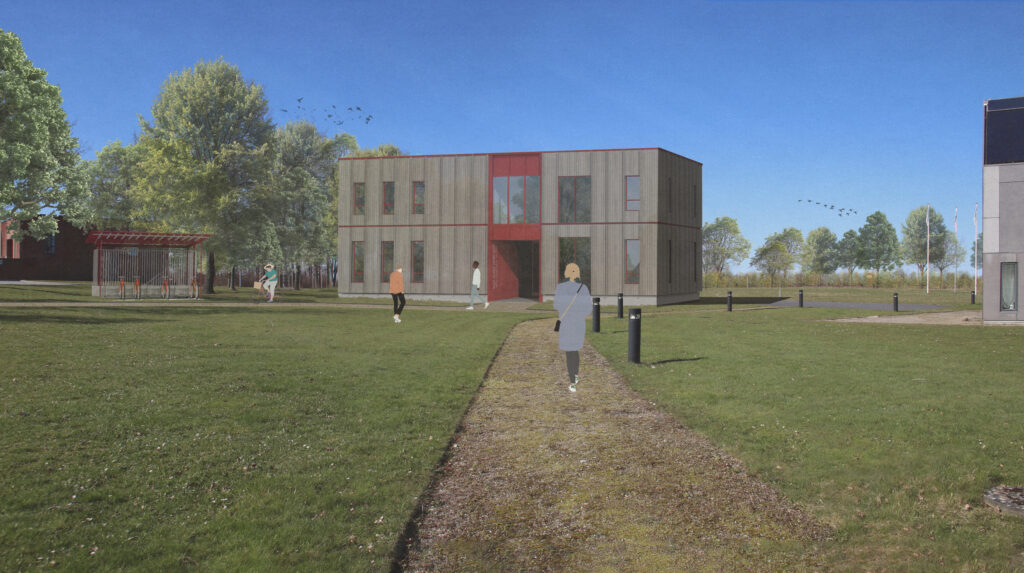Optimised to offer flexibility of design whilst using timber efficiently
The Build-in-Wood system comprises a design approach and kit of parts for building in timber, optimised for buildings of between 5 and 10 stories. A huge proportion of construction demand currently resides at this height and the corresponding structural demands allow the enhanced capacity of engineered timber products to be effectively exploited.
Designed for predominantly residential and/or commercial projects the system is afforded the potential to suit various scenarios and enable future changes in use due to its flexibility. Selection of components from a carefully designed range enable the system to adapt to the often drastically different needs of any given project, without the inherent redundancy that can often result from a solution designed for multiple scenarios.
The system incorporates a structural frame and a non-structural facade, devised for use holistically as well as independently to encourage reuse, retrofitting and extensions of existing building stock, which the consortium recognise as a fundamental component of sustainable construction. Material efficiency has been constantly reviewed and considered for its relevance to embodied carbon and to ensure cost efficiency.
Simple principles that capitalise on the myriad benefits of prefabrication and repetition of components underpin the system. In addition, ease of fabrication, transport, and installation, as well as disassembly at end of life, were all considered within the design of the system itself. The system is designed as ‘open source’ using generic, widely available products, and materials to avoid impacting issues such as procurement and competitive tendering.
Defining the bay
The Build-in-Wood structural system uses a post and beam frame in engineered timber, offering flexibility of internal configuration as well material efficiency, allowing more buildings to be constructed from the timber we have available globally.
Flexibility of internal layout is vital for designing buildings of different functions; also offering the potential to reconfigure spaces to change or modify their function during or post construction, helping to guarantee longevity from an environmental perspective and for a client’s investment.
The main bay is designed as a flexible open space with perimeter columns only. The system uses a hierarchical grid wherein the primary span is greater than the secondary span. This approach is most structurally efficient, and typically offers both material and cost savings, with minimal impact on the internal layout due to the flexibility already inherent within the ‘column free’ primary bay.
A range has been defined for the width, depth and height of the bay based on analysis of spatial requirements and material performance. Column, beam, and slab sizes correspond to these dimensions, their sizes adjusted to suit the differing structural demands of each scenario.
Once defined, the ‘typical bay’ can be iterated in 3D to create different building forms. Using the bay as a ‘Lego’ block, this repeatable component can be arranged in infinite configurations.

Building geometry
Acknowledging the floor construction depth challenges of a post and beam approach, the Build in Wood system configuration has been developed with a clear servicing strategy. Primary beams are oriented perpendicular to the facade, spanning out from a central servicing corridor. The narrow width of this corridor reduces the required beam depth, enabling central service distribution across the building’s length without passing under the deep primary beams.
From this main spine, services are distributed into individual bays in between the primary beams, ensuring services can reach all areas of the building without dropping below the datum of these beams. This configuration allows for the rational distribution of high-level services, as well as creating a natural circulation and access zone beneficial for both residential and office layouts.
The building’s core(s) can conform to the grid, occupying a bay or bays, or can sit outside of the grid. The latter allows the core to become a vehicle by which the naturally rectilinear building form can be suited to the irregularities of a real-world site; connecting, infilling, and/or reorienting respective ‘blocks’ of the building massing.
With this understanding it is possible to consider how the simple geometry of the system can adapt to varied sites whilst at the same time providing the building’s stability and maintaining an efficient solution for most of the floor area. A more generous irregular void can be filled with a more generous core, be that in the form of a courtyard, atrium, or other space.

Performance criteria
The basic components of the system have inherent performance for vibration, fire, and acoustics; however, additional build-ups and linings have also been defined to enable this minimum performance to be enhanced and tailored to specific project requirements as defined by the client and local requirements.
Solutions are typically outlined for low, mid, and high requirements, defined from the range of performance levels within Europe, however extreme scenarios may require additional measures. Where possible, different solutions are set out that allow the structural timber components to either be concealed or exposed to help promote the exposure of timber surfaces for regulation of the internal environment and beneficial effects on wellbeing due to an innate connection to nature.
These solutions must be appropriately selected by the design team to ensure the extent of exposed timber surface is aligned to all requirements for the specific project, particularly pertaining to fire. The developed solutions are predominantly ‘dry’ wherever possible, aligning to the system aspirations for quick and easy installation, and demounting to encourage re-use at the end of the building’s life towards a circular economy.
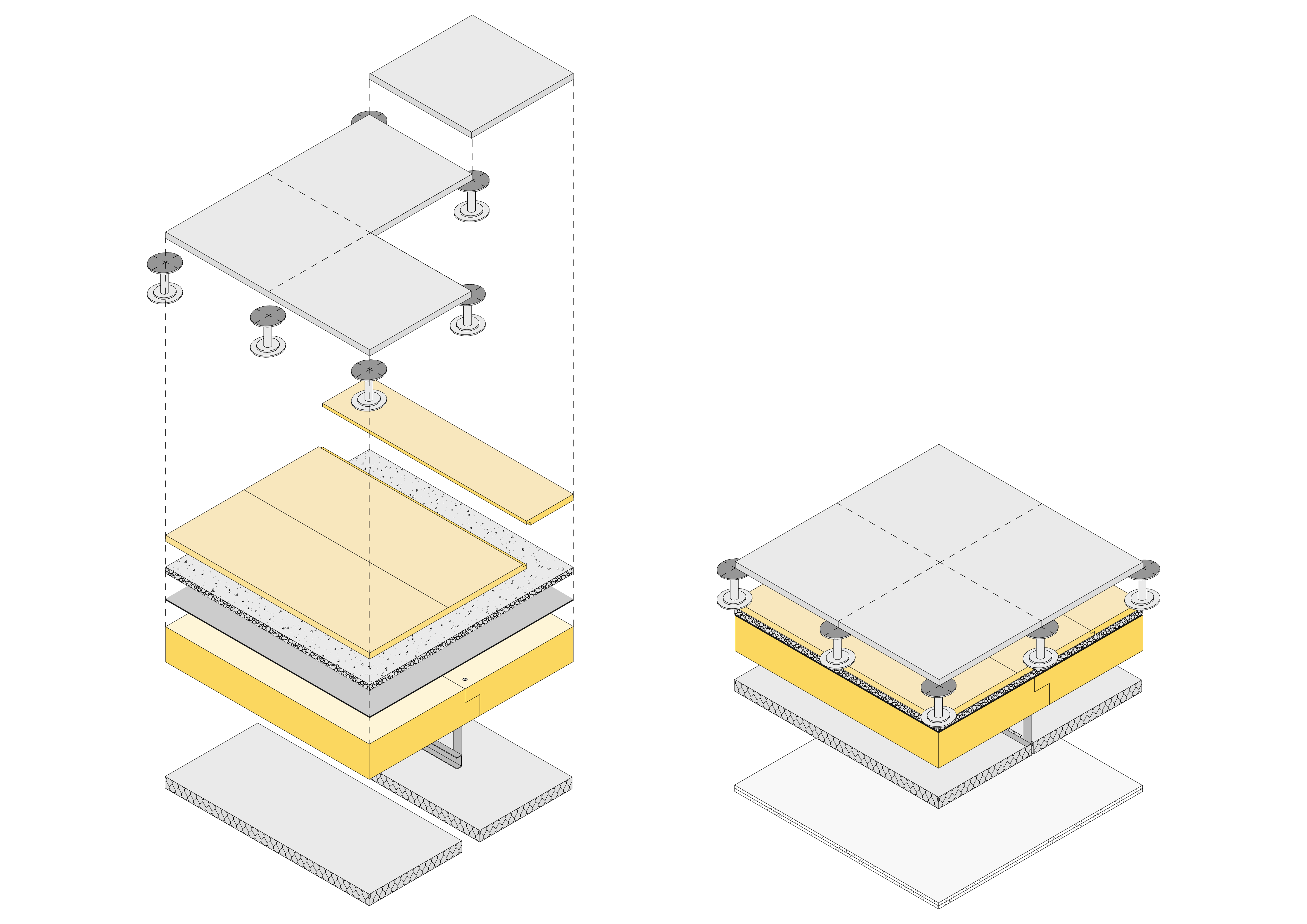
Assembly
Connections have been considered and developed for all key interfaces within the structural system. The use of steel connectors is typically unavoidable in engineered timber buildings of this scale due to the loads, however, simplifying the approach to these connections has the potential to offer not only carbon, but also cost savings.
The system uses predominantly simple, widely available and certified, brackets and screws as well as notches and ledges that can be easily pre-routed into the relevant timber components, allowing the connections to capitalise on bearing capacity. Fire protection has been considered for all connectors, whether exposed or concealed behind gypsum linings, and the timber itself is used to provide protection to steel connectors where possible.
As one of the most prevalent and often challenging connection types, the column to beam connection has been a key area of focus in developing system. The connectors developed and proposed for the Build-in-Wood system can be preinstalled within pre-routed recesses in the relevant components prior to delivery, allowing the connections to be simply slotted together on site. This type of connection fully aligns to the project ambition to facilitate installation as well as disassembly and re-use, something that is only feasible due to the incredibly high tolerances of prefabricated engineered timber components.
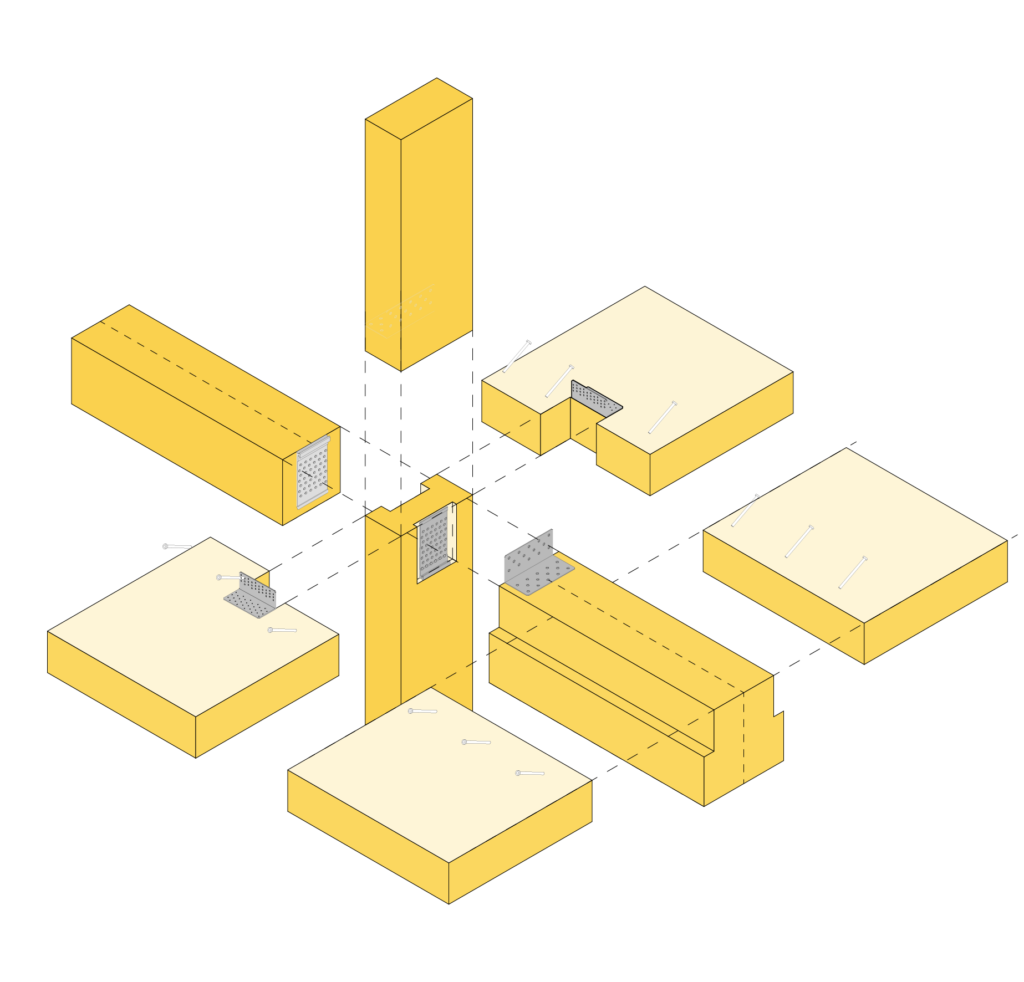
Defining the panel
The Build-in-Wood façade system is designed as a prefabricated panel comprising a light timber frame substructure onto which variable layers are added, both internally and externally, that can be tailored to suit the specific thermal, fire and acoustic performance levels required.
The facade elements are non-loadbearing, meaning they need only to support their own weight and distribute wind load back to the primary structure. As such, a framed solution can achieve the structural demands on the panel without the redundant material incurred using a solid substrate (such as CLT), offering a more materially efficient solution. An OSB sheathing board is included internally to provide the necessary structural racking, particularly useful for lifting and installation.
The system has been designed to avoid the need for scaffolding (subject to cladding type), as this was identified as a key driver to reduce time and costs on site. Solutions have been developed to allow the various integrity lines of the building envelope to be sealed from the building interior, or via the use of self-expanding seals and careful, robust detailing.

Geometry, openings & connections
Maximum panel sizes are ultimately constrained by manufacturing, transportation, and installation. In addition, smaller components are generally easier to work with, which can in turn save on building time, however their use may also result in increased lifts, connections, and interfaces, to the opposite effect. Accordingly, it is essential to find an optimal balance in scale.
The Build-in-Wood facade panels are ‘single storey’ and horizontally oriented, delivered to site in their ‘final’ orientation, maximising the potential for prefabrication. This approach also enables the simplification of the connection back to the primary structure to a single angle bracket, specifically developed to connect both the head of a lower panel and base of an upper panel. These connections can be made from inside the building, at low-level, minimising work at height to increase site safety.
The size of panel can be adapted to suit the floor-to-floor and bay width of any project using the Build-in-Wood structural system. The façade panels can also be used wholly, or in part, for the refurbishment of an existing building; modifications to the connection detail to enable fixing of the panels to a different structural frame, considering differential movement, must be established on a case-by-case basis.
A fixed depth for the facade panel’s structural frame – and consequent structural capacity – allows for a consistent set of ‘rules’ within which openings can be designed. This approach provides maximum flexibility for the elevations to achieve the desired architectural intent and aesthetic. The defined ‘opening’ rules allow full height openings for level threshold access onto balconies and terraces, considering variations in floor build up for different building types.
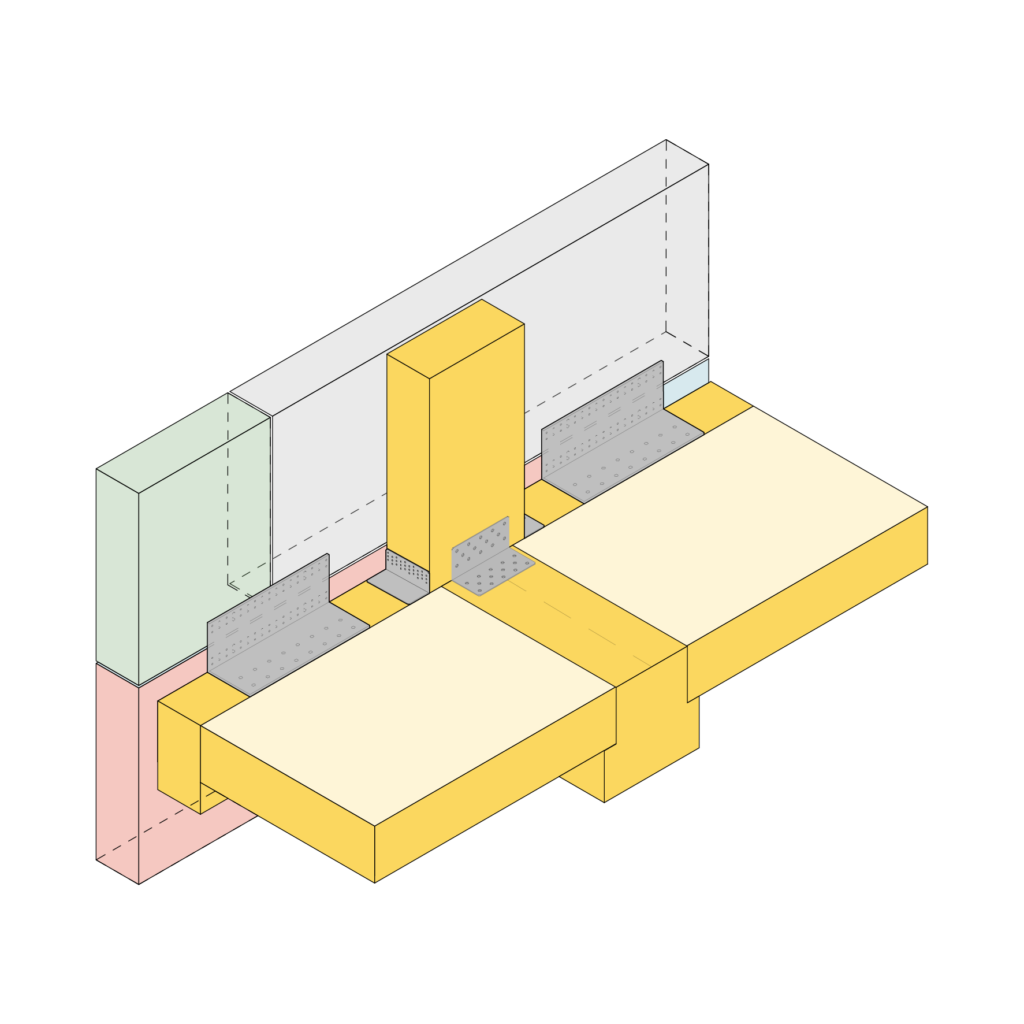
Performance criteria
As well as architectural or aesthetic variability, the facade of a building has myriad performance criteria to achieve. Considering the multiple combinations of different performance levels for different criteria, the number of solutions required for the Build-in-Wood facade system could quickly become unmanageable.
For simplicity and efficiency, a system of three layers has been developed to isolate adjustments in performance for different criteria into different layers of the stratigraphy.
Fixing the depth of the substructure to facilitate a single set of rules for openings, also results in the thickness of insulation between the posts being fixed, consequently predetermining its contribution towards performance criteria, namely thermal.
This fixed layer demands for the variability in thermal performance to be assigned to the external lining, which also provides the cladding and its support system. The variability in fire and acoustic performance is then separately assigned to the internal lining. This approach ensures a limited set of iterative solutions both for the internal and external layers, which can be selected independently and then combined to create a unique build-up tailored to the needs of a given project.
The use of timber and other bio-based products has been prioritised for each layer to maximise their application, where permitted by regulations. Reaction to fire and durability of bio-based products has been interrogated, with non-combustible alternatives and advice for ensuring durability provided throughout the guide. Designers are themselves responsible for compliance with local codes and regulations.
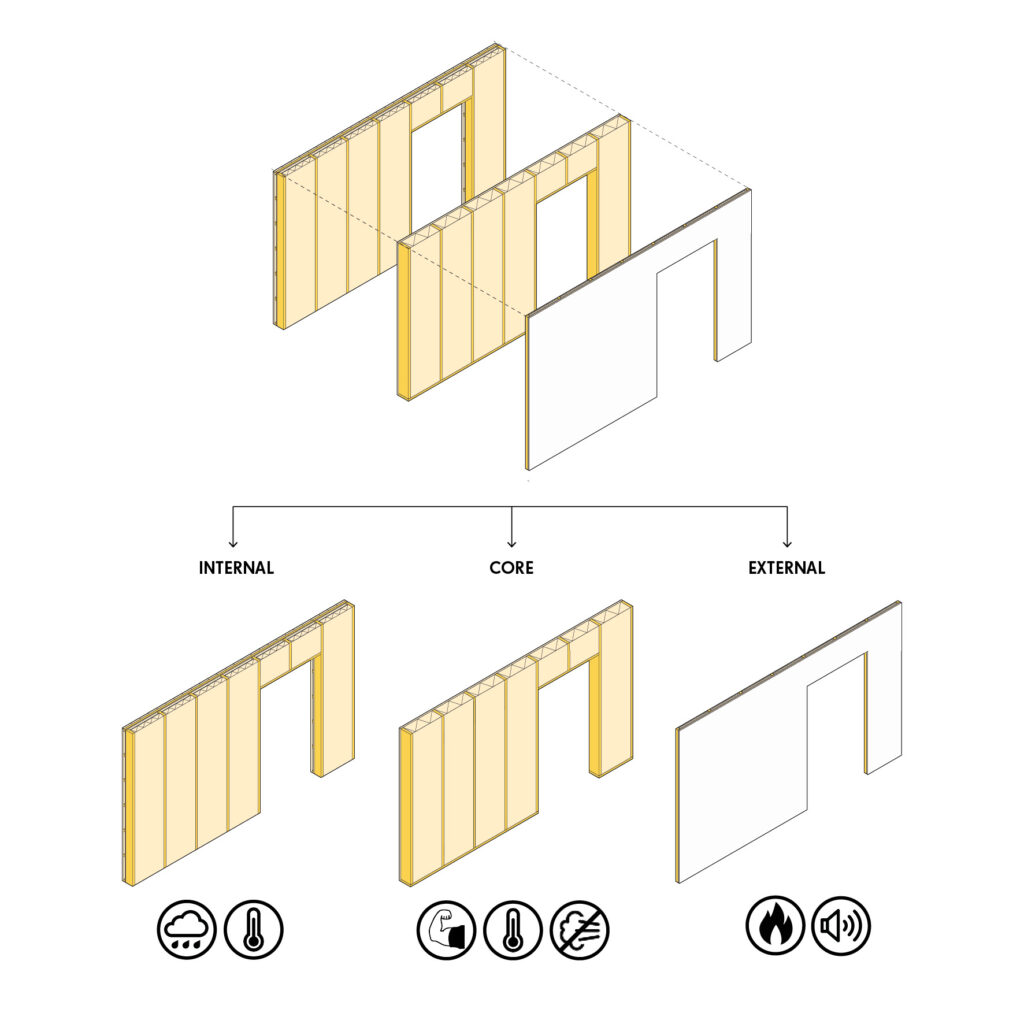
Are you interested in learning more about the Build in Wood System?
Have a look at the Build in Wood System Guide, the Build in Wood Component Selector and the Build in Wood Assembly Manual to get an even better understanding of the system.

